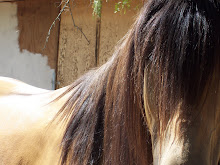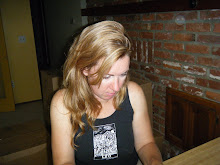Friday, July 19, 2013
The Chicken or the Egg
When you see a golden horse spanish walking across a parking lot at your new boarding barn, it tends to get your attention. At least it gets my attention. This was the first time I saw my friend Teresa and her horse Saint, the kiger mustang, working together. My immediate thought was "That's awesome! Her and I are going to be friends." Poor Teresa, I must have seemed like that annoying , lonely neighbor who lays in wait and chirps "yoo-hoo..." every time you poke your nose out the back door. In any case from these very humble beginnings grew a fine friendship with a fine horsewoman. Like all horse people we had arrived at our current level of horsemanship through various paths. Me on fire with the natural horsemanship I had just learned via John Lyons and she with her mentor, Harry Whitney. The conversations we shared where often very spirited! Because I was so newly christened in the method of my choosing, I could not grasp the nuance of what Teresa was sharing. I secretly wanted to be as "organic" and "agendaless" as she was but had a very hard time letting go of the method I felt so suited to.
The biggest sticking point was, how is "direct the feet to get the change in thought" different from "direct the thought to get the change in feet". Reading it today it seems much less murky, but then I'm way older( ahem) and fresh from a Harry Whitney week long clinic. So back then, I didnt understand the fact that it makes a big difference in how the horse feels about all of it. Its no secret in Lyons training that we use the feet and lungs to get the horse to change his thought or search for a new answer. Done well, this should look no more taxing than a simple lunge line warm up in a round pen. Done poorly, well, most of us have seen it done poorly. Don't get me wrong,I'm not here to bash another method, especially one that I am forever grateful to for opening my eyes to a whole new way of being with horses, not to mention giving me a pretty kick ass career for the past 14 years. However as most of you reading this know, I've been a bit lost in my horsemanship journey, these past four years. Simply put I was ready to see the difference now.
Imagine this conversation between Teresa and I:
Me: yeah but, how do you address a horses thought..I mean physically how do you do it?
Teresa: you direct his thought.
Me: yeah but, what do you do, specifically?
Teresa:you direct his thought....
She demonstrates by pointing to the right and her horse walks to the right....
Me: so you are driving his head away?
Teresa: no.... im not driving anything, im directing the thought.
she points left and her horse goes left
Me: so...you did an inside turn? but how did you get his feet to go?
Teresa: BY DIRECTING THE THOUGHT!!!!!
You get the picture, its amazing she didn't run screaming when I showed up at the barn! In any case I could not grasp the big difference or the big deal with the big difference, except, I wanted to know how she got her horse to try all these cool things she taught him. I mean my horses didn't seem that interested in tricks nor could i figure out how to break down a trick to teach them so I wrote it off to, me not really needing to be interested in learning tricks, after all I had a method to teach clients that was practically fool proof and made their horses gentle/ safe for them. End of story right? Noooooooo......
What is the big difference? In a nut shell , how the horse feels about you, and what you are asking him to do for you. Now before there is a hoopla about how airy fairy this all sounds, take a good look at how your horse responds to your requests, does he seem dull,nervous,grouchy,stiff,frantic,lazy? The list goes on and on with words describing lackluster response from the horse. Is the secret that once the horse gets used to it, understands it, has done it enough times for you that this changes? well, in my limited experience yes and no. In other words his performance in our eyes, may improve, but in his head does it really? I believe in his head it doesn't and I'll talk about that in more detail later. This is why three equine teachers have been sent to me to try to help me get this concept. The first, was a little white lippizan, he was very facially expressive and shall we say, physically expressive in a polite way, under saddle. Anyone who has ridden Nibs( now named Nigel) when he was displeased about anything, can recall how hard he stabbed his little hooves into the ground, jarring kidney and filling alike! Yet, I could not see it and plugged away uttering my Lyonisms for comfort and support. Here are three Lyonisms that fit this situation : #1 Im sorry, but do it any way.#2 The horse must be calmer after the lesson than before it began. #3 get it, get it consistently, get it consistently where you want it then improve on it.
Then came Cuervo, who was physically challenged enough to not be able to do the repetitions needed in conditioned response to really get anywhere with the JL system. If anyone for a minute thinks the universe is not obvious in its irony just think about this for a moment. Here is this fabulous little horse Beth and he needs you, but guess what? you cant train him like all the others you have worked with, because you will break him. So have fun, buh bye! Then finally, there is Leo( may I be worthy of this wonderful creature)Who said consistently, I don't like it, try something else or I wont play. All while being so freaking magnetic I couldn't keep my hands off of him. AY CARAMBA!
So lets move on to what I learned from each of these fabulous equines. Nibs while obvious in his responses, I simply wrote off as not a good match for me anyway, Beth: 1 Universe: 0, so from him, sadly, I learned not very much at the time. Hind sight as they say is 20/20 though. Cuervo, well, Cuervo I learned several new approaches to try and had some limited success, I strangely felt safe on him, even as others thought I was in very grave danger. In the end, I was injured by him and that's when I hit bottom in my horsemanship. You see he was the first one I tried to be more organic with, more fly by the seat of my pants with. I guess technically I did fly too, just not the way I wanted. Now we have Leo, he is a challenge, and my life line in my horsemanship. I am well aware of his responses to my ham handed requests, he was seriously displeased. I got bit...a lot, grumpy ears, a lot, Oh so lack luster responses alot. Seized up feet,wierd hinges in the wrong places, zero interest in even trying new things. I felt as if all we did is poke back and forth at each other like some brother and sister act. Luckily for him,the new approaches I used on Cuervo,elicited the same behaviour so I had to keep searching and even luckier for both us, Teresa sent me Harry Whitneys schedule, and wouldnt you know he was only three hours away. And wouldn't you know, they had a rare last minute spot open up, and wouldnt you know, my truck sold and I had a bit of extra cash. Universe 1, Beth:0.
Day one of the clinic I saw Harry direct the thought, I saw a very flighty, busy arab,do exactly as Harry asked, in a calm and interested manner. I saw that arab reach for what he offered when a few moments before she was trying to get away and out of the arena. So you can say I was hooked, right then and there. The way its done does not cause the horse to try to get away from you. It does not drive the horse or bring up the "flee" in the horse. Its not consequence training. It offers what Im ready to have now with my horse, what I've always wanted to have with my horse. An understanding and trust and mutual satisfaction.
14 years ago I wanted a different way with horses than I had learned at equine college and found John Lyons. As John himself always told us,"Horses are the best hobby in the whole world, because you will never know it all when it comes to horses. You will continue to grow and learn through out your life time with them. How great is that?" I say pretty darn great. Looking forward to the next 45 years myself. Heres to paso shaped life lines,new beginnings and true horsemanship.
Subscribe to:
Posts (Atom)



